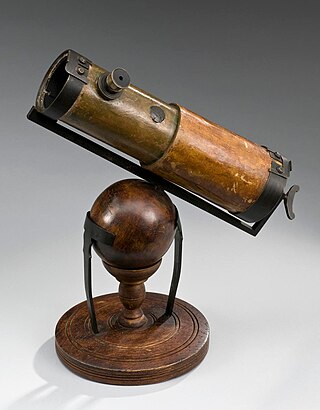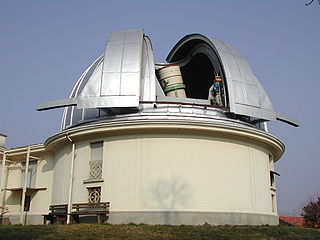| Name | Aperture | Type | Significance | Location | Year |
| Meter | Inch |
| Gran Telescopio Canarias (GTC) | 10.4 m | 409" | Reflector – Segmented, 36 | World's largest 2009 | ORM, La Palma, Canary Islands, Spain | 2009 |
| Large Binocular Telescope (LBT) | 8.4 m x 2
(22.8 m LBTI) [5]
| 464.5" | glass mirror reflector – Multi-mirror (2) | World's largest 2008 with Beam Combiner | Mount Graham International Observatory, Arizona, USA | 2005 |
| Hobby-Eberly Telescope | 9.2 m | 362" | Reflector – Segmented, 91 | First HET | McDonald Observatory, USA | 1997 |
| Keck 1 | 10 m | 394" | Reflector – Segmented, 36 | World's largest 1993 | Mauna Kea Observatory, Hawaii, USA | 1993 |
| Hubble (HST) | 2.4 m | 94" | glass mirror reflector | Largest Visible-light space based telescope | Low Earth orbit NASA+ ESA | 1990 |
| BTA-6 | 6 m | 238" | glass mirror reflector | World's largest 1976 | Zelenchukskaya, Caucasus | 1976 |
| McMath-Pierce Solar Telescope | 1.61 m | 63" | glass mirror reflector | Largest solar telescope | Kitt Peak National Obs., USA | 1962 |
| Hale Telescope (200 inch) | 5.08 m | 200" | glass mirror reflector | World's largest 1948 | Palomar Observatory, California, USA | 1948 |
| Samuel Oschin telescope | 1.22 m | 48" | glass mirror reflector – Schmidt camera | World's largest Schmidt camera 1948 | Palomar Observatory, California, USA | 1948 |
| George Ritchey 40-inch (1 m) [6] | 102 cm | 40" | glass mirror reflector | First large Ritchey-Chrétien | Flagstaff, Arizona, USA (Washington, D.C. until 1955) | 1934 |
| Plaskett telescope [7] | 1.83 m | 72" | glass mirror reflector | Designed as world's largest but beaten by the 100-inch Hooker telescope | Dominion Astrophysical Observatory, Canada, USA | 1918 |
| Hooker Telescope | 2.54 m | 100" | glass mirror reflector | World's largest 1917 | Mt. Wilson Observatory, California, USA | 1917 |
| Hale 60-Inch Telescope | 1.524 m | 60" | glass mirror reflector | The first of the "modern" large research reflectors, designed and located for precision imaging. [8] [9] | Mt. Wilson Observatory, California, USA | 1908 |
| Great Paris Exhibition Telescope of 1900 | 125 cm | 49.21" | refractor – achromat | Largest refractor ever built, scrapped after Exhibition. | Exposition Universelle (1900), Paris, France | 1900–1901 |
| A. A. Common's 60-inch Ealing reflector [10] | 1.524 m | 60" | glass mirror reflector | World's largest glass mirror reflector 1889, sold to Harvard 1904, moved to South Africa 1920s (Boyden Observatory) where it was largest telescope in the southern hemisphere. | Ealing, Harvard College Observatory, Cambridge, Massachusetts, USA;Boyden Observatory, South Africa | 1889 |
| Yerkes Refractor | 102 cm | 40" | refractor – achromat | Largest operational refractor | Yerkes Observatory, Wisconsin, USA | 1897 |
| A. A. Common's 36 inch Ealing reflector | 91.4 cm | 36" | glass mirror reflector | First to prove fainter than naked eye astrophotography; [11] sold, became Crossley Reflector | A. A. Common Reflector, Great Britain / Lick Observatory, California, USA | 1879 |
| Great Melbourne Telescope [12] | 1.22 m | 48" | speculum metal mirror reflector | Last large reflector with a speculum metal mirror, world's largest equatorially mounted telescope for several decades. [13] | Melbourne Observatory, Melbourne, Australia | 1868–1889 |
| William Lassell 48-inch [14] | 1.22 m | 48" | speculum metal mirror reflector | | Malta | 1861–1865 |
| Rosse telescope: Leviathan of Parsonstown | 1.83 m | 72" | metal – speculum metal mirror reflector | World's largest 1845 | Birr Castle, Ireland | 1845–1908 |
| William Lassell 24-inch [15] | 61 cm | 24" | speculum metal mirror reflector | | Liverpool, England | 1845 |
Great Dorpat Refractor (Fraunhofer)
Dorpat/Tartu Observatory | 24 cm | 9.6" | refractor – achromat | "...the first modern, achromatic, refracting telescope." [16] [17] | Dorpat, Governorate of Estonia | 1824 |
| Rosse 36-inch Telescope | 91.4 cm | 36" | speculum metal mirror reflector | | Birr Castle, Ireland | 1826 |
| Herschel's 40-foot (126 cm d.) [1] | 1.26 m | 49.5" | speculum metal mirror reflector | World's largest 1789 | Observatory House, England | 1789–1815 |
| Herschel's 20-foot (47.5 cm d.) [18] [19] | 47.5 cm | 18.5" | speculum metal mirror reflector | | Observatory House, England | 1782 |
| Reverend John Michell's Gregorian reflector [2] | 75 cm | 29.5" | speculum metal mirror – Gregorian reflector | World's largest 1780 | Yorkshire, Great Britain | 1780–1789 |
| Dollond Apochromatic Triplet [20] | 9.53 cm | 3.75" | Refractor – apochromat | First apochromatic triplet | England | 1763 [20] |
| Father Noel's Gregorian reflector [2] | 60 cm | 23.5" | speculum metal mirror – Gregorian reflector | World's largest 1761 | Paris, France | 1761 |
| James Short's Gregorian reflector | 50 cm | 19.5" | speculum metal mirror – Gregorian reflector | World's largest 1750 | Great Britain | 1750 |
| James Short's Gregorian reflector | 38 cm | 14" | speculum metal mirror – Gregorian reflector | World's largest 1734 | Great Britain | 1734 |
| Chester Moore Hall's Doublet [21] | 6.4 cm | 2.5" | Refractor – achromat | First achromatic doublet | Great Britain | 1733 |
| Hadley's Reflector [22] | 15 cm | 6" | speculum metal mirror reflector | First parabolic newtonian | Great Britain | 1721 |
| Christiaan Huygens 210 foot refractor | 22 cm | 8.5" | Refractor – Aerial telescope | World's largest 1686 | Netherlands | 1686 |
| Christiaan Huygens 170 foot refractor | 20 cm | 8" | Refractor – Aerial telescope | World's largest 1689 | Netherlands | 1686 |
| Christiaan Huygens 210 foot refractor | 19 cm | 7.5" | Refractor – Aerial telescope | World's largest 1686 | Netherlands | 1686 |
| Hooke's reflector [3] | 18 cm | 7" | speculum metal mirror – Gregorian reflector | First Gregorian | Great Britain | 1674 [23] |
| Newton's Reflector [24] | 3.3 cm | 1.3" | speculum metal mirror reflector | First reflecting telescope | England (mobile) | 1668 |
| Hevelius refractor | 12 cm | 4.7" | Refractor | World's largest 1645 | Gdańsk (Danzig), Poland | 1645 |
| Hevelius Scheiner's helioscope | 6 cm | 2.3" | Refractor | World's largest 1638 & First Equatorial [21] | Gdańsk (Danzig), Poland | 1638 |
| Galileo's 1620 telescope | 3.8 cm [4] | 1.5" | Refractor | World's largest 1620 | Italy | 1620 |
| Galileo's 1612 telescope | 2.6 cm [4] | 1" | Refractor | World's largest 1612 | Italy | 1612 |
| Galileo's 1609 telescope | 1.5 cm [4] | 0.62" | Refractor | World's largest 1609 | Italy | 1609 |
| Hans Lippershey's telescope | ? cm | .?" | Refractor | World's first recorded telescope | Netherlands | 1608 |













